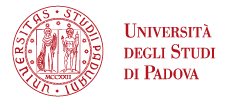PRIN 2022 / Palomba

Acronimo: eXoft
Titolo: Innovative soft-rigid exoskeleton for smart factory
Responsabile scientifico: dott.ssa Ilaria PALOMBA - Dipartimento di Ingegneria Industriale-Università degli Studi di PADOVA
Coordinatore: dott. Luca CARBONARI– Università Politecnica delle MARCHE
Partner-Unità di ricerca: Dipartimento di Ingegneria Industriale-Università degli Studi di PADOVA, Scuola Superiore di Studi Universitari e Perfezionamento Sant'Anna, Politecnico di TORINO
Bando: PRIN 2022 - Decreto Direttoriale n. 104 del 02-02-2022
Durata: 28/09/2023 – 27/09/2025 (24 mesi)
Budget totale progetto: € 225.753,00
Abstract del progetto
Work related musculo-skeletal disorders represent a relevant percentage of occupational diseases in developed countries. Aside the laborers discomfort, they also reflect on companies with relevant economic effects. Nonetheless, the spread of exoskeletons for industrial applications is still limited. The reasons are to be sought on how they are perceived by workers: for many of them, their reduced mobility and not perfect adaptability to the kinematics of the human body make them more of a nuisance than a real help.
Because of that, the use of exoskeletons in industry has been till now limited to non-ergonomic tasks that involve maintaining uncomfortable postures for extended periods. It is the case of over-head jobs in automotive assembly lines. In such cases, where just supporting the arms weight imposes prolonged stress on muscles, passive shoulder and arms exoskeletons have been demonstrated being beneficial for stress release. In many other applications in which workers could take advantage of external supports (e.g., repetitive lifting of loads from the ground in logistics), the use of exoskeleton is limited since the devices are perceived as an impediment to comfortable walking.
The spread of wearable devices in industrial scenarios could bring advantages not only to jobs ergonomics and injuries assessment, but also to safety and risk management. The exoskeletons worn by labourers can be conceived as tools able to share quantitative data about the user posture and position within the working environment. Such pieces of information can then be used for active safety strategies, such as collision prevention and machines command.
In few words, the object of the eXoft project is an active exoskeleton with innovative mechanical and actuation designs, conceived for integration in collaborative robotics environment. The purpose is to improve the comfort and safety of labourer tasked with heavy or repetitive jobs, while providing a tool for a safer integration of human-in-the-loop workflows.
The technological and scientific advancements required by the project will be pursued by four macro-activities: design and prototyping of a hybrid (soft-rigid) mechanism, design of a human-robot interaction control, design of an innovative actuation paradigm, and integration of the device features in collaborative robotics work scenario. Each activity will be carried out by a different unit and will step through the definition of design methods and requirements which will converge in an innovative device.
The key idea is that of getting rid of the limitations given by traditional exoskeletons by introducing soft elements in the kinematic structure aimed at enhancing the motility perceived by the user. Also, the design of a novel device will allow to integrate it with the necessary extero- and proprio-ception ability useful for integration in a wider collaborative work environment.





